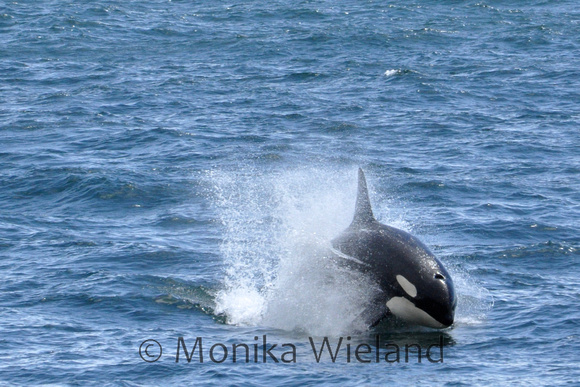K-Pod has still been scarce this summer, but J-Pod and various parts of L-Pod have been around a lot. I spent a nice afternoon with members of both pods last Tuesday, June 26th, but it took a while to figure out just who I was seeing! By comparing notes with a few friends who were both on shore and on the water at various times of day, I've pieced together the specifics of what happened:
In the morning, all of J-Pod and all of the L-Pod whales that were in (L12s, L55s [aka L4s], L72s, L47s) were up north. In the morning, half of J-Pod (J11s, J17s, J22s) came south in Haro Strait. Later, the rest of the Js and the Ls were at Turn Point, and the other half of J-Pod (J2s, J14s, J16s) split off and went back north up Swanson Channel. When I got to Land Bank's Westside Preserve at 12:45 PM, I saw just the L-Pod whales heading south.
I was about to leave, but when driving past Hannah Heights I saw the whales had turned around and grouped up closer to shore. No going home now! I went back to Land Bank and saw the L-Pod whales again, now with the J11s, J17s, and J22s, go north, and then south again until about 3 PM.
Follow all that? It seems that in my early days of watching whales here in the early 2000s that the pods didn't split up as much. I think this is partially true, but I also wasn't able to ID the whales as well so probably missed some of the nuances of different whale associations. It's an interesting glimpse into killer whale society to see all the changing associations; for instance, when the rest of L-Pod left on June 27th, four whales (L53 and the three L72s) stayed with J-Pod. I don't think we saw very much of that type of thing ten years ago.
Okay, I just had to write that all out to get straight in my head what happened! Now, for some photos.
The first group of whales that came back north were traveling at high speed. Several whales were sharking, or swimming at high speed with just part of their dorsal fins above the water, creating a splash at the surface and also allowing you to track just how fast they're swimming underwater. The above photo shows the top of an adult male's dorsal fin in the back as he's "sharking".
 |
| Another example of an interesting association: L41 Mega with J27 Blackberry, two adult males from different pods |
Some other whales were porpoising, which is where more of their body lunges to the surface when they're swimming at high speed, creating a tremendous splash. It's a difficult behavior to photograph, because it's hard to track where they will surface and it happens so quickly. Often the photos will be like this one, a little blurry and not showing much of the whale at all:
But my timing was just right on this one - my prize shot of the day!
 |
| See a larger version of this photo here |
After the first group of whales passed, the others were coming much slower, making it easier to get some IDs.
 |
| L72 Racer, a 26 year-old female |
 |
| L95 Nigel, a 16 year-old male and brother of Racer |
The whales didn't get far again before turning back south, doing what many people call the "westside shuffle" just going up and down the westside of San Juan Island. A group of three whales was hanging out pretty close to shore before heading south:
I like the angle on this shot, as the three whales turned to head offshore:
Finally, a quick bird note: a recent ferry ride turned up my first Heermann's gull (209) of the season - the first time I think I've seen one up here in the month of June. Also, somehow I hadn't seen marbled murrelets (210) yet until that same ferry ride, putting me within just 5 species of my year list goal of 215 and still half the year to go!





3 comments:
Hi monika
love reading your blog.i have to travel to scotland to see alot of the whales and dolphins.i come from dover kent england.
we do get the occasional dolphins in the english channel.always nice to see.
iam a keen birdwatcher as well seen some of your birds over here ring-billed gull, sandhill crane etc.they always cause a twitch.
Hi Monika
210!!! Really struggling to keep up with you now! Could do with a trip to Dungeness but it's a long long way from here (probably not by US standards)
Is the sharking behaviour just for 'fun'? Certainly looks fun
Cheers
Davo
Dungeness - Thanks for posting! It's always fun to read blogs from "across the pond" where common birds cause a stir, and rare birds are common! Glad to hear you're enjoying the blog.
Dave - I expect the year list will hit the skids for quite a while now, so you'll have some time to catch up! Sharking can definitely be for fun - I've seen them do it when they're surfing in big waves, like in the wakes of freighters. Other times I think they're just swimming fast close to the surface and the top of their tall dorsal fin just happens to be above the surface! For instance, this happens when they're pursuing a fish just below the surface.
Post a Comment